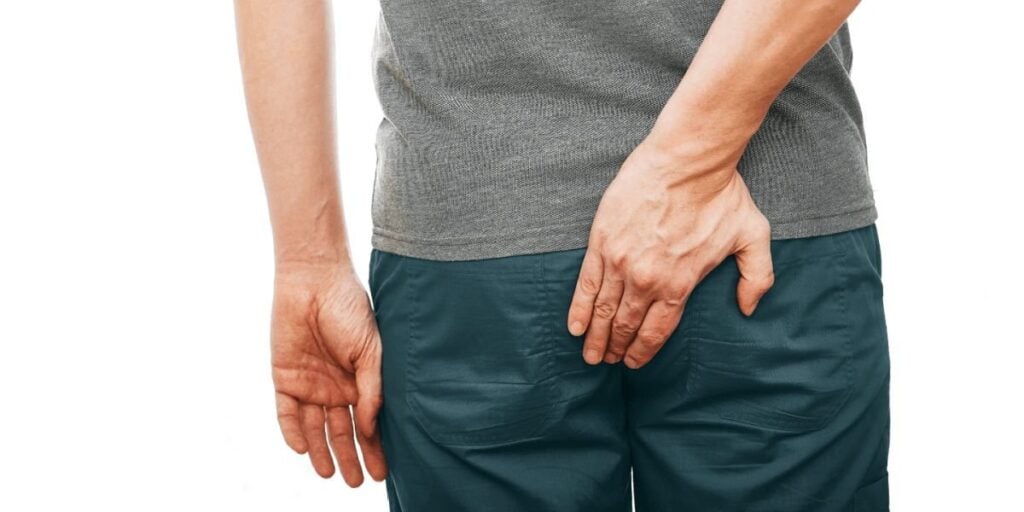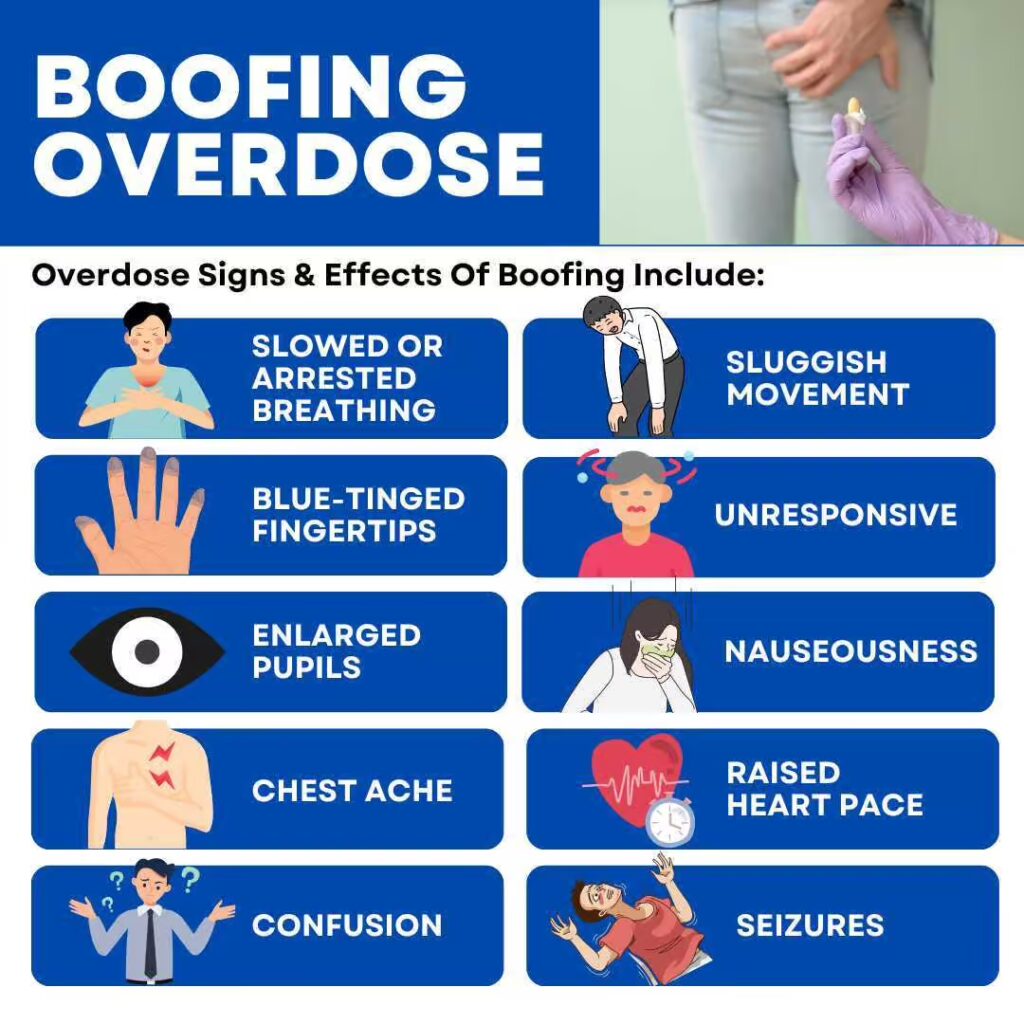Boofing is taking drugs or alcohol through the rectum for a quicker and stronger high. It uses the rectum’s blood vessels for fast absorption into the bloodstream. While effective, boofing has serious risks like infections and overdose. This guide explores what boofing is, why people do it, and how to minimize its dangers.
Key Takeaways
- Boofing is the rectal administration of substances, offering faster and more intense effects due to quick absorption, but it carries significant health risks.
- Common substances boofed include stimulants like cocaine and depressants like alcohol, with heightened overdose risks due to rapid absorption and lack of metabolic filtering.
- Practicing safety and hygiene is crucial when boofing, as risks include infections, anal damage, and potential overdose; recognizing signs of addiction and seeking treatment is essential.
What is Boofing?

Boofing is a slang term for the rectal administration of substances. This method involves introducing drugs or alcohol into the rectum to achieve a more intense high compared to other methods like smoking or oral ingestion. The term “booty bump” is often used interchangeably with “booty bumping,” highlighting the same process. People boof for various reasons, but the primary motivation is usually the desire for a faster and more potent effect, sometimes referred to as butt chugging.
Various substances can be used for boofing due to the rectal area’s many blood vessels, which enable quick absorption into the bloodstream and bypass liver metabolism. This results in a more immediate and intense high, making the method appealing despite its risks.
How Boofing Works
In boofing, the substance is mixed with water and injected into the rectum using a needleless syringe or baster. The syringe is inserted about one centimeter into the anus, and the plunger releases the mixture, allowing rapid absorption through the rectal blood vessels.
Boofing can take several forms, such as suppositories, micro-enemas, and specialized catheters. Common materials include needleless syringes or basters. Using clean and sterile boofing equipment is vital to minimize the risk of infection, particularly when sharing boofing equipment to live safely.
Understanding the mechanics of boofing is crucial due to its rapid absorption and bypassing of liver metabolism, making it a potent method of substance administration. However, it also comes with significant risks.
Substances Commonly Used in Boofing

A wide variety of substances are commonly boofed, ranging from stimulants to depressants. Drugs like heroin, cocaine, and methamphetamine are frequently used due to their intense effects. Alcohol is also commonly boofed, as it leads to rapid intoxication and can be more potent than drinking. When it comes to boofing alcohol, the effects can be felt almost immediately, making it a popular choice for those seeking a quick and intense high.
Fentanyl, a potent opioid, is increasingly found in various different drugs that people choose to boof, adding to the risk of overdose. Other illicit drugs like LSD and GHB are also used in this practice. The choice of substances can vary, but the common goal is to achieve a faster and more powerful effect.
Why Do People Choose Boofing?
People choose boofing for several reasons, primarily due to the quicker onset of effects compared to oral consumption. The effects can be felt in as little as five minutes, making it an appealing choice for those seeking immediate gratification. The rectum’s numerous blood vessels allow drugs to enter the bloodstream quickly, bypassing significant liver metabolism and leading to a faster and more intense high.
Additionally, some individuals opt for boofing to avoid the adverse effects associated with other routes of ingestion methods. For example, boof drugs can minimize the risk of nausea and vomiting that sometimes accompanies oral drug use, making it an unusual route and a safer alternative.
However, turning to boofing for a quicker and stronger high can also indicate a potential substance use disorder related to boofing.
Health Risks and Complications
Boofing comes with significant health risks and complications. Common issues include infections, anal damage, and the risk of overdose. Prioritizing hygiene is crucial to minimize infection risks, such as washing hands with soap and water before and after the process and using new, sterile equipment. Repeated boofing can damage the anal region, leading to complications like rectal bleeding, abscesses, and inflammation.
The risk of overdose is also higher with boofing due to rapid absorption and the inability of the body to purge the substance. Understanding these risks is essential for anyone considering boofing. Let’s delve deeper into each of these health risks to grasp their severity fully.
Infections
Engaging in anal sex administration of substances significantly increases the risk of bacterial and fungal infections. The rectal area is sensitive and prone to mucosal injury, which can lead to a higher likelihood of contracting a sexually transmitted infection. Regular testing for sexually transmitted infections (STIs) is crucial to safeguard health after participating in boofing.
Hygiene practices are vital to reducing the risk of infections. Using sterile equipment and washing hands thoroughly can help minimize the chances of bacterial and fungal infections. However, the increased risk remains a significant concern for anyone considering this method of substance use.
Anal Damage
Prolonged boofing can lead to severe complications that may require surgical intervention. The act can cause physical damage to the anal sphincter and rectum, leading to pain and bleeding. If not addressed, these injuries can result in significant long-term health issues, including chronic pain and bleeding.
Individuals may experience bloody stool and discomfort, which are signs of potential damage to the colon and digestive system and digestive tract. It’s essential to monitor for any signs of injury and seek medical attention if complications arise.
The risks of anal damage make it crucial to approach boofing with caution and awareness, especially when considering the potential impact on the butt.
Overdose Risk
Boofing carries a high risk of overdose due to the rapid absorption of substances through rectal administration. The risk is heightened because the body can’t trigger a gag reflex or purge the substance, leading to potentially fatal consequences. Substances like opioids (heroin and fentanyl), stimulants (cocaine and meth), and even alcohol pose significant overdose risks when boofed.
The rapid onset and intense high make boofing particularly dangerous. Substances enter the bloodstream quickly, bypassing the liver’s first-pass metabolism, which can lead to overdosing before any warning signs appear. Understanding these risks is crucial for anyone considering this method of drug use, as it can result in a faster onset of effects.
Symptoms of Overdose from Boofing

Recognizing the symptoms of an overdose from boofing is vital for timely intervention. Common signs include confusion and altered mental states, which indicate that someone may be experiencing an overdose. Respiratory issues, such as slowed or stopped breathing, are critical indicators that require immediate medical attention.
In severe cases, an overdose from boofing can lead to unconsciousness. Other symptoms to watch for include nausea and dizziness. Given the high risk of overdose associated with boofing, knowing these signs can be life-saving.
Recognizing Substance Use Disorders
Habitual boofing can signal the presence of a substance use disorder. Recognizing addiction signs early is critical to addressing substance use disorders, particularly in individuals who frequently use methods like boofing. Substances like ketamine, MDMA, and certain prescription medications are often boofed to enhance their effects.
Common signs of addiction include increased tolerance, withdrawal symptoms, and neglecting responsibilities to use substances. It’s essential to recognize these signs early to encourage individuals to seek appropriate treatment and support.
Treatment Options for Boofing Addiction
Treatment options for boofing addiction often include inpatient rehabilitation facilities that provide immersive care, as well as outpatient programs allowing for more flexibility. Seeking professional assistance is crucial for individuals struggling with boofing addiction to facilitate recovery and prevent relapse.
In addition to professional help, support groups and counseling can play a significant role in the recovery process. Addressing the underlying issues that lead to substance use and substance abuse is essential for long-term recovery and preventing relapse.
Safety Tips for Those Who Boof
Safety should be prioritized for those who choose to boof. Having a bowel movement beforehand can reduce discomfort. Adequate lubrication helps minimize friction and prevent rectal damage. Starting with a small dose and waiting to assess its effects can prevent overdosing, especially when considering practices like an alcohol enema.
After use, the syringe should be discarded properly to ensure safety. Monitor for any signs of bleeding or tearing, as some drugs may mask pain and delay awareness of injuries. These safety tips can help minimize the risks associated with boofing.
Summary
Boofing, or rectal administration of substances, offers a quicker and more intense high but comes with significant risks and complications. Understanding how it works, the substances commonly used, and the health risks associated with it is crucial for anyone considering this method. Recognizing the signs of substance use disorders and seeking appropriate treatment can help those struggling with addiction.
If you choose to boof, prioritize safety by following recommended practices to minimize risks. Always consider the potential consequences and seek professional help if needed. Stay informed, stay safe, and make decisions that prioritize your health and well-being.
Frequently Asked Questions
What is boofing?
Boofing is when someone uses the rectum to take in drugs or alcohol, often to get a stronger effect. It’s important to be aware of the risks involved with this method.
Why do people choose to boof drugs or alcohol?
People often choose to boof drugs or alcohol because it leads to faster effects and a more intense high, as the rectum’s blood vessels allow for quick absorption into the bloodstream. This method bypasses the typical metabolic processes, making the experience more immediate.
What are the risks associated with boofing?
Boofing comes with serious risks such as infections, anal damage, and even overdose from rapid substance absorption. It’s crucial to consider these factors before engaging in this practice.
How can I recognize an overdose from boofing?
If someone is experiencing confusion, respiratory problems, or becomes unconscious after boofing, it’s a clear sign of an overdose and they need urgent medical help. Always take these symptoms seriously!
What treatment options are available for boofing addiction?
The best way to tackle boofing addiction is to seek professional help through inpatient rehab, outpatient programs, or counseling. It’s important to get the right support for a successful recovery.


